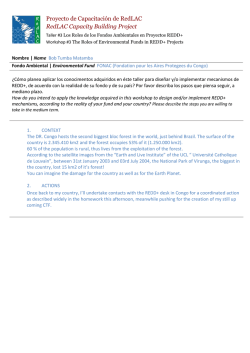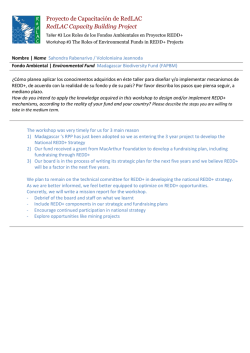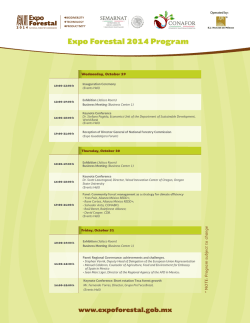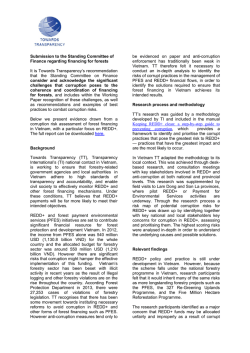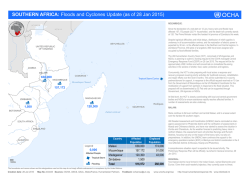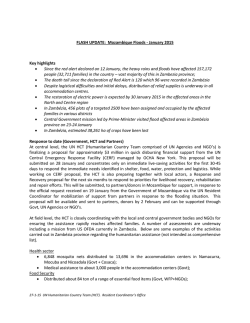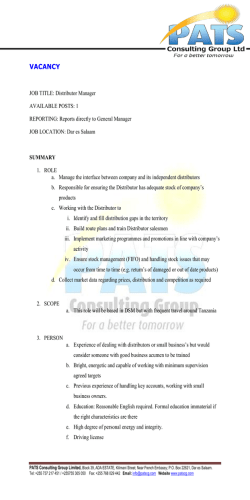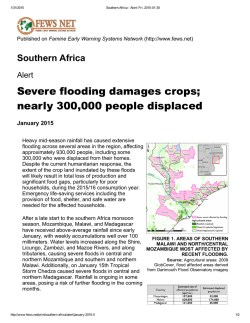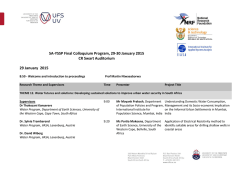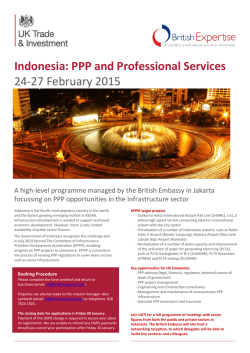
Testing REDD+ mid-term review terms of reference (PDF)
Consultancy for Mid Term Review of the project: Testing REDD+ implementation in the Beira Landscape Corridor in Mozambique Manica, Sofala and Zambezia I. Project summary Mozambique is among the countries piloting REDD+ mechanisms, supported by multilateral and bilateral financing and is in the process of developing its REDD+ strategy as well as testing implementation of REDD+ on the ground. It is in this context that the Norwegian government is funding a three and a half year initiative to implement REDD+ in one of the key landscapes and development corridors in Mozambique, the Beira landscape corridor. This follows previous support through the ‘South-South REDD+ project’ that led to the development of the REDD+ readiness plan which is currently being implemented to pave the way for a national REDD+ strategy and operation of REDD+ programmes. IIED has been facilitating the REDD+ process in Mozambique since 2009 having contributed significantly to the REDD+ readiness preparation proposal (RPP) approved in March 2012 by the Forest Carbon Partnership facility (FCPF). As part of that process, research in Manica around the forest reserves of Moribane-Maronga-Zombe and the Chimanimani Transfrontier Conservation Area showed annual biomass and carbon losses of 3.1 per cent between 2007 and 2010. This is an alarming figure because firstly, the study site was near areas which are supposed to be protected forests, and secondly it was located within the Beira landscape corridor (Manica and Sofala and Zambezia Provinces) in which developments are taking place rapidly and pressures on forests are unlikely to decrease. There is now an urgent need to firstly assess, the extent to which that study site was representative of the reality across the broader Beira landscape corridor, and secondly, what investment packages might realistically help to avoid deforestation and degradation. Figure 1 indicates the location of the project and the key features that determined the choice of this area for REDD+ testing. The provinces of Manica, Sofala and Zambezia are endowed with several natural resources including forests and arable land. It is also an area of focus for development with key infrastructure such as roads, railways and harbours being key to propel the economy. As a result, many investment interests are attracted to the area. This includes small and large scale mining, harvesting forest products, forest plantations (monoculture for pulp and paper industry) and agriculture. These development opportunities are desperately needed to improve the dire situation of poverty under which 55 to 70 per cent of the population of this area live. Employment and generating higher tax revenue is high on the development agenda. Yet there are also risks regarding lack of enforcement of sustainable land use investments and potential for rapid depletion of resources. It was to address this challenge that IIED and partners decided to implement a comprehensive initiative to address the drivers of deforestation and forest degradation. 1 Project implementation area 232,006 Km2 Just over 7 million people, with 55-70 per cent leaving below the poverty line Nearly 1.5 farming households cultivating just over 1.5 million ha 3.75 million ha of forest land under concession regime (76 concessionaires) Endowed with forests, minerals, high potential for forest plantations (3 million ha), arable land, water and fisheries resources as well as infrastructure – Beira Machipanda road as well as the Sena railway connecting the hinterland countries with the coast (Beira Harbour) Figure 1. Project and area and key characteristics The goal of the project is therefore “to provide detailed landscape-level analysis across the Beira Corridor of the rates and drivers of both deforestation and degradation, design and test potential REDD+ delivery models and investment packages, including calculations of their implementation and transaction costs, and inform the Mozambique national debate on the institutional and operational options that require attention in the (separately funded) REDD readiness preparation process”. The main outputs of the project will include: 1. 2. 3. 4. 5. 6. 7. A socio-economic baseline for REDD+ implementation in the Beira landscape corridor including patterns and trends in land and natural resource rights and use. A sub-national baseline for deforestation and degradation within the Beira landscape corridor based on historical rates adjusted in the light of development plans. A set of designed REDD+ delivery models and investment packages to avoid deforestation and degradation targeting communities, the private sector and government An analysis of local preferences for, and economic viability of, these investment packages and delivery models – including their likely social and environmental impacts Practical implementation test results (based on a carefully managed REDD+ investment fund) for the more preferred, viable and effective investment packages and delivery models. A set of lessons drawn from these analyses to inform the national REDD+ readiness preparation process. Engaged and prepared people in Manica, Sofala and Zambezia in particular the Centre for Sustainable Development (CDS), provincial directorates of environment (DPCA) and of agriculture (DPA), MICAIA, 2 ORAM, IIAM, UEM and local academic institutions ready to take these analyses, results and lessons forward in practical actions. Preference will be given to REDD+ delivery models that avoid deforestation through change in practices that are ultimately more profitable for land users (after the initial investment to secure land use change). For example, it might be possible to invest in a transition away from shifting cultivation towards more productive and profitable agroforestry models, or a transition away from uncontrolled and inefficient charcoal production towards managed woodlots with more efficient and profitable charcoal kilns. The project will manage a REDD+ investment fund to test the more promising investment packages and delivery models. A robust and accountable fund management committee will be established (including regular oversight by the Norwegian Embassy of all funds committed) and provisions for independent auditing. However, in addition to the direct REDD+ investment fund, the project team will also engage with managers of other existing finance streams in order to explore how to mobilise on-going investments (such as AgDeCo and others) to support activities that will result in reducing emissions, hence contributing to promoting greengrowth. An experienced consortium of IIED, together with local partners (MICAIA, UEM and CDS), will form the core group of implementing partners. IIED will also manage a number of sub-contracts to supplement the roles and expertise of this team to ensure adequate coverage of all project areas. IIED will be present in Mozambique through a consultant, hired to ensure day to day project management and liaison with partners, including the national REDD+ working group and other stakeholders. In addition, a formal process of liaison between the project partners and stakeholders will be secured through the establishment of advisory boards at provincial and national level. Provision is made for an independent external review of the project, and early in the project implementation a risk assessment will be conducted with main partners to establish areas that need strengthening in terms of transparency and accountability mechanisms. The project budget is £1,970,288 (NOK 19,111,793) of which £0.9 million constitutes the catalytic REDD+ investment fund to test the implementation of REDD+ investment packages and delivery models. The project will be implemented between 1st September 2012 and 31st December 2015. The full project document including the results framework will be shared at the beginning of the scope of this review. The project is managed and coordinated by the International Institute for Environment and Development (IIED). IIED is an independent policy research organisation established in 1992 which works with partners on five continents to tackle key local and global issues. The mission of IIED is to build a fairer, more sustainable world, using evidence, action and influence in partnership with others. This initiative is part of the projects implemented by the Forest Team which is part of the Natural Resources Group. The team works on forests and climate change and implements projects such as Inclusive REDD+ (funded by the UK Government) and Testing REDD+ (the subject of this review). Other current work include Forests in the Green Economy, Forests and Sustainable Development Goals, Forest Farm Facility run in collaboration with FAO and IUCN, Forest Connect and demand side measures for reducing deforestation. The IIED team involved in the implementation of Testing REDD include personnel in the United Kingdom and in Mozambique. The project is implemented in partnership with the University of Edinburgh (UK) and Mozambique-based partners comprising the Centre for Sustainable Development (CDS) of Natural Resources, a technical institution of the Ministry for Coordination of Environmental Affairs (MICOA), based in Manica province; the Mozambique Institute for Agrarian Research (IIAM) - Delegation for the Central Region, based in Manica province; the Eduardo Mondlane University (UEM) including the Faculty of Agronomy and Forestry Engineering (FAEF) and the Centre for Policy Analysis (CAP) of the Faculty of Arts and Social Sciences (FLCS), based in Maputo; the Foundation for Community Development (MICAIA), based in Manica; and, the national 3 NGO supporting security of community land tenure (ORAM) based in Zambézia. These partnerships with local institutions from government, academia and NGOs are particularly important for scaling up and long term engagement in REDD+ delivery models that this initiative will help to establish or harness. •Coordination of the initiative, •Contract with Norway and all partners; • Lead economic analysis, baseline REDD+ investment packages, costs and policy implications; safeguards •Documentation and communications •Accountable for project performance •Communication with UT-REDD+ •Lead coordinator of field research and logitics for Manica and Sofala •Socioeconomic baseline including mapping land rights •Lead the implementation of REDD+ delivery models in Manica •Liaison with ORAM-Zambezia and iTC •dentification of partnerships to implement the REDD+ investment packages IIED MICAIA CDS UEM (IIAM, UoE and local universities) •Contribute to mapping land rights and input into definition of reference levels •Key liasion institution with government agencies at provincial level (environment, agriculture, mining, etc.) and central level •Coordinate biophysical research; •conduct research on the various areas identified •Liaise with local universities and research institutions to form teams, •Provide training were nedded for completion of research Figure 2. The consortium and key roles that they play in the initiative The project set to establish a steering committee to provide strategic direction to the project and to engage with wider stakeholders in the process of implementation of this initiative. II. The review This review of the project aims to examine the progress (26 months) in implementation of the project and make recommendations on improvements that can be made going forward. Some of the key questions that it should aim to answer are: i) Are the activities being implemented as planned? ii) Are the outputs being delivered on time and to the agreed quality? iii) Are the project’s assumptions holding and are they still valid? iv)Have staff adapted the project’s assumptions in the light of project experience (a proxy indicator for learning)? v) Are risks being managed satisfactorily? vi) Is expenditure at agreed levels and is resource use efficient? vii) Are systems such as M&E in place and functioning as planned? 4 viii) Does the logic (theory of change) of the intervention still hold? ix) Is the programme team engaging sufficiently with gender and generational issues? Key documents for the review Project document for Testing REDD+ including budget and audit reports Stakeholders reports – 2012, 2013 and 2014 Annual reports submitted to the Embassy of Norway and minutes of the annual formal meetings of IIED and the Embassy of Norway Drafts of studies and briefings – socioeconomic, assessment of loss of carbon stocks and REDD+ delivery models. Reports submitted by partners on contracted activities. Reports produced/published in the course of the months of the review will be equally shared with the review team. For overall background and context the review team can also look at South-South Reports, the Mozambique RPP and the CIFOR publication on drivers of deforestation and forest degradation. II.1 Tasks 1. Assess the approach of TREDD initiative Review the project document objectives, outputs and the results framework to gauge the extent of its implementation, challenges faced and how they have been remedied. o Was it specific, efficient, effective, creative, innovative, impactful, sustainable and did it promote strong and durable institutional relationships? Review the implementation structures including formal and less formal partnerships (see Figure 1, the project document, annual reports, minutes of the formal annual meetings between IIED and the Norwegian Embassy in Maputo and the stakeholder meeting reports that will be provided) formed in the first 26 months of implementation of the initiative and assess the extent to which they have been implemented, how efficient they are and what can be done to improve them. With regard to implementation structures, the review team should reflect on the IIED project management structure (one FTE UK based and one FTE Moz based) and provide an assessment of its effectiveness and how it can be improved. Analyse the appropriateness and flexibility of the approach to adapt to the different nature of partnerships involved in the initiative. Assess the effectiveness of wider partnerships with government institutions at different levels, private sector, NGOs and communities. Of particular interest are the Ministries of Agriculture, Energy, Environment and others (again these should be listed and how these partnerships contribute to the project’s objectives outlined in an annex). Assess the effectiveness of communication between IIED and the donor during the implementation of the project. Review expenditure to date and comment on it as well as looking at the remaining budget and determining if it will be sufficient to deliver the remaining outputs – see point on internal audit Assess whether the results framework including assumptions and risks made in the project document are still relevant. 5 2. 3. Have the risks been managed satisfactorily and how could things have been done better? Evaluate the management and administration of the initiative: assess effectiveness and efficiency of systems of internal coordination and leadership of the initiative. Assess the capacity of IIED and partners to deliver on the commitments made on the project. Assess the robustness of the systems to deal with demands placed by the implementation of this type of initiative. Assess performance of TREDD to date Assess the progress made and extent of achievement of objectives, outputs and indicators set out for the initiative. Determine the extent to which the activities have been undertaken according to the original plan and subsequent plans developed annually, identify challenges or bottlenecks and propose remedies for the initiative going forward. Assess the adequacy of resources awarded to partners to undertake various components of the work and the level of performance in delivering the expected results. Assess the adequacy of resources for IIED to deliver its outputs. Assess the extent to which gender is being addressed in the implementation of the initiative – participation and how men and women will be or are being involved as well as impacted by this initiative. Evaluate the soundness of the REDD+ delivery models and how they have been developed and assess the extent to which they will be effective in addressing the drivers of deforestation and forest degradation. Assess the adequacy of various studies and connections to construct an approach for REDD+ implementation at subnational level that can provide lessons for REDD+ elsewhere. Assess effectiveness of the initiative in leveraging additional funds for its implementation beyond the current phase funded by the Government of Norway. Assess the interest that other donors and Mozambique government might have in providing further support to the activities being undertaken by partners on the ground. Review materials presented in the three annual meetings and training activities undertaken since September 2012 to December 2014 in order to assess the adequacy of the issues covered in light of the outputs, activities and indicators. Further, this should review the extent to which the discussions are relevant to the national level REDD+ policy process. Assess a possible exit strategy for the initiative. Draw lessons on the approach and performance adopted for implementation of REDD+ in the Beira corridor landscape Identify key lessons of working with partners both in formal and informal relationships and how that was capitalised on and how it can be strengthened to achieve the objectives of TREDD. Identify lessons on innovative approaches and practices adopted to ensure the achievement of the project outputs. Draw lessons on communication and effectiveness in influencing policy and/or practice to help inform the work going forward. Identify opportunities for sustainability (finance and technical support) of the REDD+ delivery models being implemented. 6 4. Make clear recommendations based on the review conducted For each of the tasks, the reviewer should provide an assessment, give details of what worked well and what could have been done better and present clear, realistic and viable (doable in the socioeconomic, political context in the country, project resources - people and budget ) recommendations to IIED, partners and if appropriate to the donor. 5. Methodology to be applied in the review Visit IIED offices in London and/or Edinburgh to discuss the implementation of the project – leadership, coordination, management and finance issues. Review documentation and products produced in the course of this initiative. Analyse the contractual partnerships established and the extent that their mandate was linked with delivery of various outputs and results framework. Meet with University of Edinburgh (UK based partner in the initiative) Visit Mozambique i) Maputo Discuss with the Norwegian Embassy in Maputo regarding their views on the initiative and progress. Meet and discuss with the local consultant coordinating field activities. Meet with partners - UEM-CEAGRE and consultants based in Maputo. Meet with a range of stakeholders based at national level in particular government (Technical Unit of REDD+, the National Directorate of Environmental Management and the National Directorate of International cooperation housing the UNFCCC focal point in the Ministry of Environment, the National Directorate of Lands and Forests of the Ministry of Agriculture, the National Directorate of New and Renewable Energies of the Ministry of Energy and other government departments as the review team might suggest) and non-government institutions (ORAM in Maputo, CTV, IUCN, WWF, Care, UNAC, Justica Ambiental and others). Meet with other donors involved in the implementation of REDD+, in particular the World Bank, development agencies (UNDP and FA0) as well as other initiatives (the DFID-run Community Land Initiative, the Irish Embassy, Dutch Embassy, Finnish Embassy and the Swedish Embassy, EU delegation) linked with the REDD+ delivery models. ii) Manica, Sofala and Zambezia Discuss with partners (UEM-CEAGRE, consultants who contributed to the socioeconomic studies, MICAIA, ORAM central and Zambezia, IIAM-Manica, CDS and target groups such as the private sector involved in timber and charcoal production, farming households, Provincial Directorates of Agriculture- forestry and agriculture extension, Environment, Energy, Mining, provincial based academic institutions such as IAC, UNIZAMBEZE, UCM, among others that might be suggested during the early discussion of this assignment) regarding their perceptions about the initiative, progress, challenges and recommended improvements. o Assess the extent to which there are practical opportunities for scaling up and ensuring sustainability of the REDD+ delivery models (conservation agriculture, biomass energy production, transformation of timber operators into sustainable concessions). 7 II.2 Expected outputs of the review Draft outline of the report to be discussed early in the assignment. Power point presentation summarizing the preliminary findings based on documentation review and field work to be shared with all partners and key stakeholders involved in the initiative in Maputo. A conference call will be organised to this effect immediately after the field visit. Report of the review, of maximum 50 pages including annexes with 1-2 pages of recommendations and 3 pages maximum of executive summary. The final report should be presented to IIED and the Embassy of Norway to discuss the recommendations and how these should be addressed. A Formal response will be written by IIED indicating actions that will be taken to address the areas that need improving. II.3 Management of the review Isilda Nhantumbo (Manager of TREDD) supported by Elaine Morrison (Forest Team Finance Coordinator) and Alastair Bradstock (Monitoring and Evaluation) who will contribute to reviewing the report. The Embassy of Norway will evaluate the terms of reference and recruitment process before IIED engagement with the consultants that will carry the work. II.4 Qualifications/experience of the evaluation team The evaluation team will comprise of two people. One team leader recruited internationally and a local consultant. The evaluation team will be expected to: Have a postgraduate degree in forestry/natural resources management/ environmental or natural resources economics Good understanding of climate change mitigation and REDD+ mechanism Experience in conducting evaluation elsewhere; Good understanding of Norwegian support to REDD+ and climate change worldwide Ability to communicate in Portuguese and English is required for at least one of the two consultants. Knowledge of Mozambique environmental and natural resources context is desirable but not required. 8 II.5 Timeframe for the mid-term review The work should be undertaken between 30th January and 30th March 2015 with the aim of presenting a preliminary draft by end of February including discussion of preliminary findings with partners. Interested candidates should submit their CV and a short description of how they plan to approach the review to the following address [email protected] and [email protected] by 10/2/2015 9
© Copyright 2026
